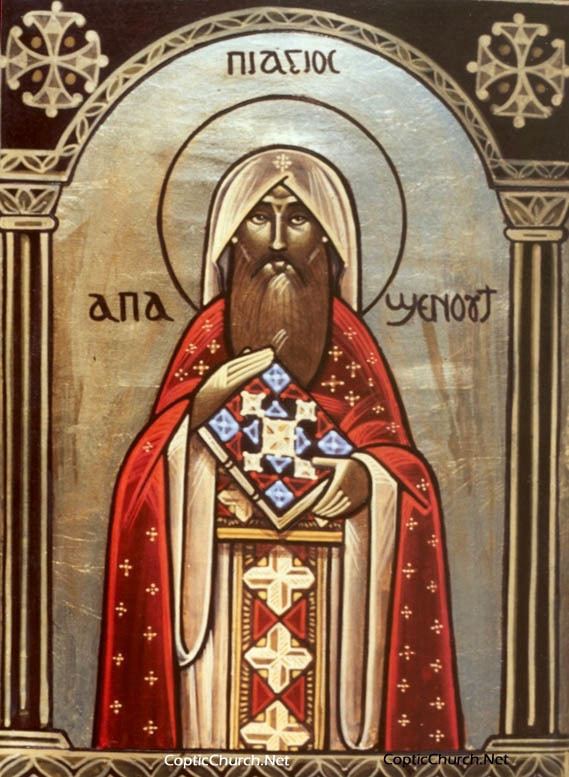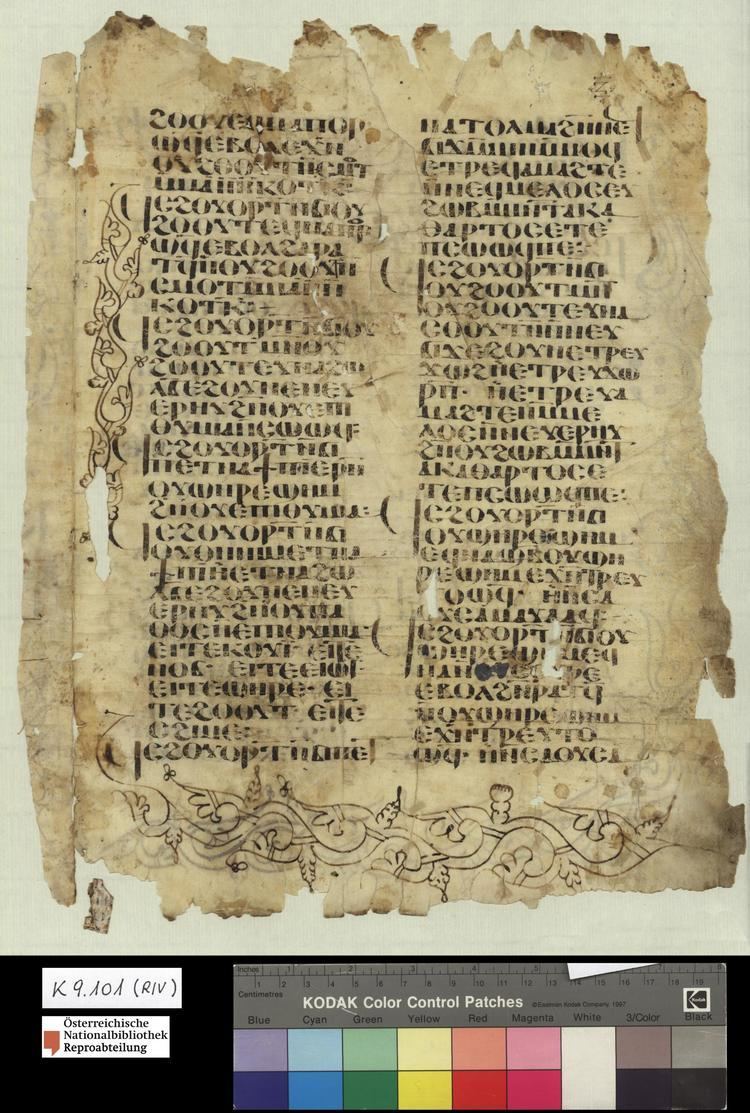Role Saint | Name Saint Shenoute | |
 | ||
Died July 14, 466 AD, Sohag, Egypt | ||
Shenoute
Shenoute the Great, Saint Shenoute the Archimandrite (Coptic: Ⲁⲃⲃⲁ Ϣⲉⲛⲟⲩϯ ⲡⲓⲁⲣⲭⲓⲙⲁⲛ'ⲇⲣⲓⲧⲏⲥ; (347-465 or 348-466) (also called Shenouda) was the abbot of the White Monastery in Egypt. He is considered a saint by the Oriental Orthodox Churches, and is one of the most renowned saints of the Coptic Orthodox Church.
Contents
- Shenoute
- Saturday The Feast of Abba Shenoute Coptic Liturgy 07142018
- Early life
- At the Council of Ephesus
- Death
- Influence on the monastic movement
- Legacy as a national leader
- Life as a writer
- Monasteries named after Saint Shenoute
- References

Saturday The Feast of Abba Shenoute Coptic Liturgy 07/14/2018
Early life
Shenoute was born in 348 AD in the Upper Egyptian village of Shenaloletto to devout Christian parents. His uncle was Saint Pigol, another famous Egyptian saint and the founder of a monastery in Upper Egypt known today as the White Monastery. At a young age, Shenoute helped taking care of his father's flock of sheep.

During one of Shenoute's trips to his uncle's monastery, Saint Pigol kept him as a result of a vision and later made him a monk. Around 385 AD, he was chosen by his fellow monks to succeed his uncle as the abbot of the White Monastery. When he took over that task, the monastery was inhabited by 30 old monks. By the time of his death in 466 AD, the monastery had 2,200 monks and 1,800 nuns, who lived over an area about 3,000 times its original size.
At the Council of Ephesus
Because of his popularity in Upper Egypt and his zeal for Orthodoxy, Shenoute was chosen by Saint Cyril the Great to accompany him in representing the Church of Alexandria at the Ecumenical Council of Ephesus in 431 AD. There he provided the moral support that Saint Cyril needed to defeat the heresy of Nestorius, Bishop of Constantinople. The eventual exile of the latter to Akhmim, Shenoute's backyard, was a testimony to the impression that Shenoute had made upon the attendees of this council.
Death
On 7 Epip (14 July) 466 AD, following a short illness possibly brought upon by advanced age, Shenoute died in the presence of his monks.
Influence on the monastic movement
From his uncle, Saint Pigol, Shenoute inherited a monastery based on the Pachomian system, though more austere and stringent. This made its followers few in number and probably promoted decline rather than growth. Shenoute implemented a more comprehensive system that was less stringent and more suitable to the surroundings and the background of the people. This new system had an unusual component, which was a covenant (diatheke) to be recited and adhered to literally by the new novices. It read as follows:
I vow before God in His Holy Place, the word which I have spoken with my mouth being my witness; I will not defile my body in any way, I will not steal, I will not bear false witness, I will not lie, I will not do anything deceitful secretly. If I transgressed what I have vowed, I will see the Kingdom of Heaven, but will not enter it. God before whom I made the covenant will destroy my soul and my body in the fiery Hell because I transgressed the covenant I made.
Transgressors of that covenant were expelled from the monastery altogether. This was considered a near death sentence for those peasant monks.
Another interesting feature of Shenoute's monastic system was the requirement for the new novices to live outside the monastery for a period of time before they were deemed worthy to be consecrated as monks. This seemed to be at odds with the Nitrian monastic system, which allowed the monks to live away from the monastic settlements only after they became proficient in the monastic life. Shenoute also utilized the time of the monks, outside prayer and worship, in more varied tasks within the monastery than the Nitrian monks were exposed to. Aside from the traditional trades of rope and basket weaving, the monks engaged in weaving and tailoring linen, cultivation of flax, leather work and shoe-making, writing and book-binding, carpentry, and metal and pottering-making. All in all, Shenouda tried as much as possible to employ the monks in their old professions. Such activities made the monastery a vast self-supporting complex, which occupied some 20 square miles (52 km2) of land.
As a monastic leader, Shenoute recognized the need for literacy among the monk. So he required all his monks and nuns to learn to read and encouraged more of them to pursue the art of writing manuscripts. This made the monastery more and more appealing to belong to and consequently made the threat of expulsion more painful.
Legacy as a national leader
In his laudatory Life of Saint Shenoute, his disciple Saint Wissa (Besa) recounts several incidents of Shenoute coming to the aid of poor Egyptian peasants. One time he went to Akhmim to chastise a pagan because of the oppression he was inflecting on the poor (Vita #81-2). Another time he acted to eliminate the cause of grief of the peasants, that the pagan landlords of Paneleou forced to buy their rotten wine (Vita #85-6). On a third occasion he risked his life to successfully ask for the freedom of the captives at Psoi from the hands of the Blemmyes warriors (Vita #89). He also at times appealed on behalf of the peasants unto those in power, even unto the Byzantine emperor Theodosius I. In summary, Shenoute fully recognized the misery of his people and emerged as their sincere advocate and popular leader.
Life as a writer
To talk about Shenoute's writing is to discuss Coptic literature at its best. He wrote in a style that was essentially his own, with writings based on a careful study of the scholastic rhetoric of his time, which displayed the wide and deep range of knowledge he possessed. They were adorned with endless quotations from the Holy Scriptures, a typical feature of patristic writings. The scriptures were quoted whenever a presented argument needed support. In doing so Shenoute also displayed an astonishing memory as he rendered these passages with amazing accuracy.
Shenoute's knowledge was not confined to the Holy Bible, as it was the case for the majority of the monks in Egypt. He was fluent in both Coptic and Greek, and was fairly well acquainted with Greek thought and theology. The sprinkling of Greek loan-words in his writings was both extensive and sophisticated, and it was definitely not a product of his living environment. He also expressed knowledge of the works of Aristotle, Aristophanes, the Platonic school, and even some of the Greek legends. He certainly read some of Saint Athanasius' works like the Life of Saint Anthony and some of his homiletic works. Shenoute also knew the letters of Saint Anthony, some of the letters of Saint Pachomius, and most likely some of the works of Evagrius. His knowledge further extended to such popular non-canonical texts as the Acts of Archelaus and the Gospel of Thomas.
The writing of Saint Shenoute can be grouped into four categories:
As more and more identifications of Saint Shenoute's literary works are made, his contribution to Coptic literature appears to be even greater than previously assumed. On the one hand, it is becoming clear that he treated a wide range of subjects, not only monastic ones. This suggests a more favorable assessment of the theological character of his writing, his spirituality, and his moral and nationalistic behavior. On the other hand, he accepted the inclusion of literary activity in the religious field. This sets him apart from the Pachomian system that tended to treat religious literature as mere written instructions with no regard to style being given. He further developed a style that is clearly a product of careful study of the scholastic Greek rhetoric of his time.
Monasteries named after Saint Shenoute
Four Coptic Orthodox monasteries worldwide are named after Saint Shenouda the Archimandrite, namely:
There is also a Coptic Orthodox church – St Mary and St. Shenouda – in Coulsdon, England.
